How long have you been a TU member? 18 years (I started when I was 15)!
Why did you become a member and what chapter are you involved with?
When I first found TU as a teenager, it was a cool non-profit that paired with my passion for fly fishing. While that's still a priority, I've paired my interest in creating sustainable fishing for generations to come with my professional background as a hydraulic engineer with focus in stream restoration. I am currently president of the Denver Chapter, where we focus on the South Platte River, but we also team with other chapters for projects throughout the state.
 What made you want to become involved with TU?
I grew up loving to volunteer and help others; during my involvement with the Boy Scouts of America from Cub Scout to Eagle Scout and beyond, I get a great sense of satisfaction from philanthropic endeavors. Oh- and I love to fish, so I should do my part to keep our waters clean, cold and fishable for generations to come. There is nothing better than a day on the river, (besides a day on the river catching fish) so I love being part of an organization where our work benefits my favorite pastime!.
What made you want to become involved with TU?
I grew up loving to volunteer and help others; during my involvement with the Boy Scouts of America from Cub Scout to Eagle Scout and beyond, I get a great sense of satisfaction from philanthropic endeavors. Oh- and I love to fish, so I should do my part to keep our waters clean, cold and fishable for generations to come. There is nothing better than a day on the river, (besides a day on the river catching fish) so I love being part of an organization where our work benefits my favorite pastime!.
What is your favorite activity or project that you have done with TU? Developing funding and studies to support the Chatfield Reallocation Environmental Pool, which will put additional water into the South Platte during the 70 zero flow days seem along the South Platte, along with developing the future Denver Metro South Platte Fishing Map.
I know you won’t tell me your top spot, so what is your second favorite fishing spot or favorite fishing story? Eagle River Rodeo Lot, Christmas Day, dumping snow...15 trout, all greater than 22 inches in 2 hours. I have no problem giving away my top spot as other anglers shouldn’t, spread the love. When you have that kind of a day, you totally forget about your freezing fingers!
What does being a part of TU mean to you? It means giving back to the community, doing my part to protect the places we love to play and spreading that awareness to others.
 What else do you do in your spare time or for work?
I am a water resource engineer and I specialize in stream restoration and watershed management. If I am not fishing I am skiing. My entire life from professionally to personally revolves around water. My wife and I love backpacking, hiking to cool spots and exploring our amazing state with our dogs.
What else do you do in your spare time or for work?
I am a water resource engineer and I specialize in stream restoration and watershed management. If I am not fishing I am skiing. My entire life from professionally to personally revolves around water. My wife and I love backpacking, hiking to cool spots and exploring our amazing state with our dogs.



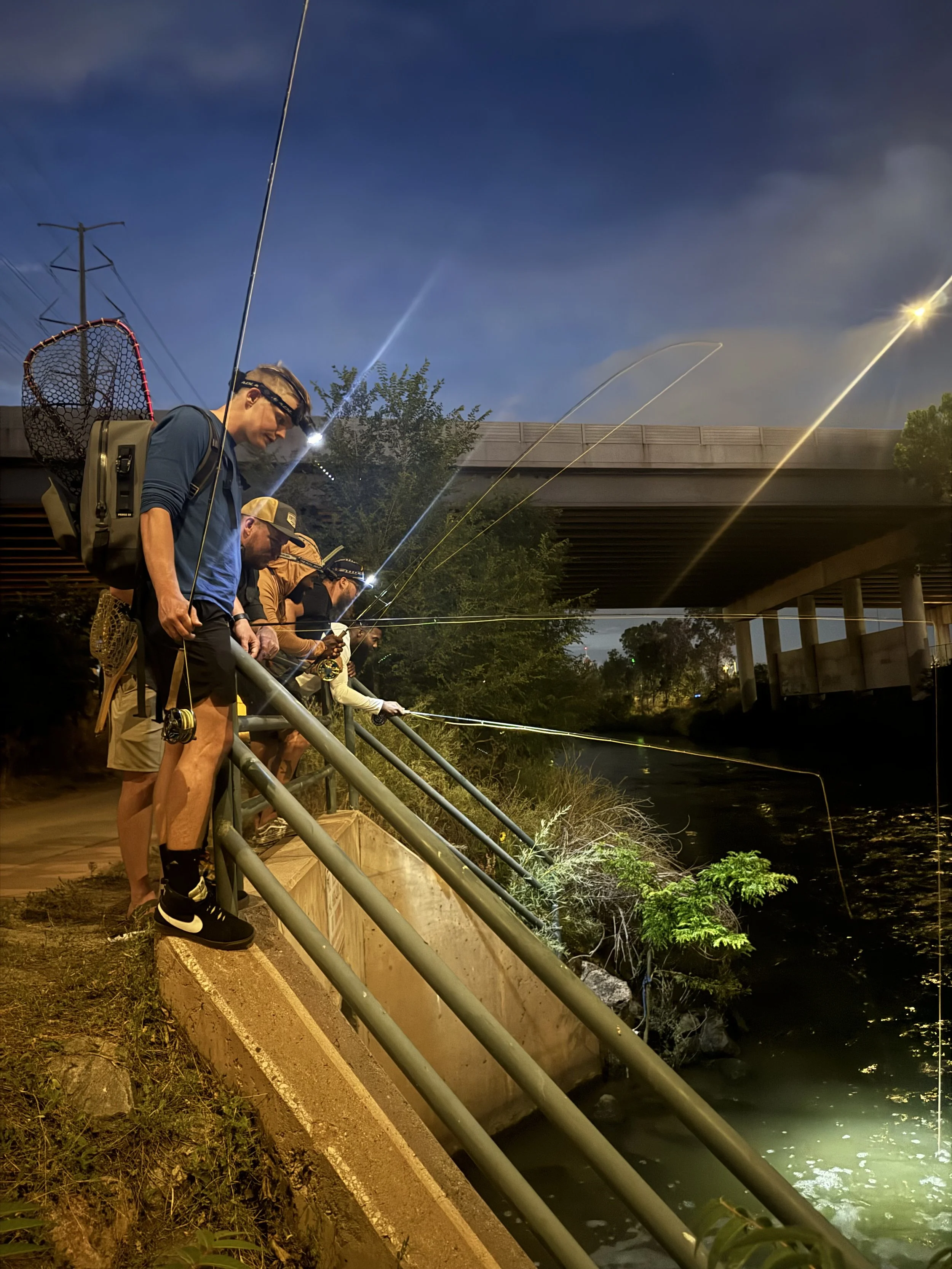


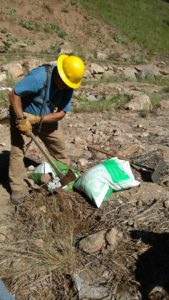
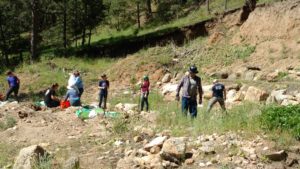

 CPW set up at the Zimmerman Lake inlet to capture spawning Greenbacks.
CPW set up at the Zimmerman Lake inlet to capture spawning Greenbacks. Fish were collected with a large net and put into a pen to be sorted and categorized by CPW staff and volunteers.
Fish were collected with a large net and put into a pen to be sorted and categorized by CPW staff and volunteers.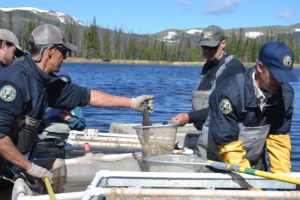 Fish were sorted based on their gender and stocking year.
Fish were sorted based on their gender and stocking year.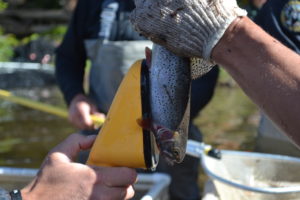 RFID chips in the fish help to identify the stocking year and other critical data.
RFID chips in the fish help to identify the stocking year and other critical data.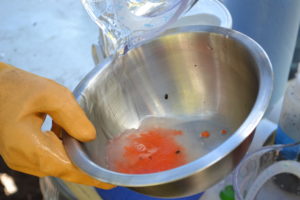 After the fish were sorted, CPW milked the males and females - making targeted genetic crosses among the various lineages to expand the genetic diversity. The eggs and sperm were combined in bowls, packed into small coolers, put on ice, and shipped to the local fish hatchery in Leadville, CO for breeding.
After the fish were sorted, CPW milked the males and females - making targeted genetic crosses among the various lineages to expand the genetic diversity. The eggs and sperm were combined in bowls, packed into small coolers, put on ice, and shipped to the local fish hatchery in Leadville, CO for breeding.
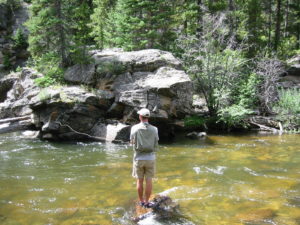 I’ve really started to love high alpine lakes, particularly backpacking into them. The solitude and natural beauty always recharges my batteries. Plus I have learned enough to usually catch some wild trout for supper. My favorite river fishing is on a stretch of the Colorado River, where my brother and I catch 18-20+ inch rainbow and brown trout. I will leave that stretch unidentified per my brother’s request.
I’ve really started to love high alpine lakes, particularly backpacking into them. The solitude and natural beauty always recharges my batteries. Plus I have learned enough to usually catch some wild trout for supper. My favorite river fishing is on a stretch of the Colorado River, where my brother and I catch 18-20+ inch rainbow and brown trout. I will leave that stretch unidentified per my brother’s request.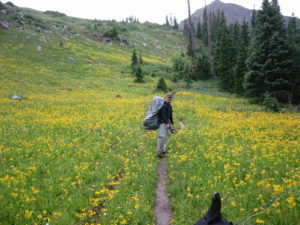 Since moving into the mountains, I have started a new career in elder care, trying to keep folks in their homes. A new focus of my fishing is the 9 wt rod I recently purchased. I’m getting into kayak fly fishing for larger fish in the Florida flats and will be fishing for some pike this summer on the Rio Grande. Love new adventures.
Since moving into the mountains, I have started a new career in elder care, trying to keep folks in their homes. A new focus of my fishing is the 9 wt rod I recently purchased. I’m getting into kayak fly fishing for larger fish in the Florida flats and will be fishing for some pike this summer on the Rio Grande. Love new adventures.

